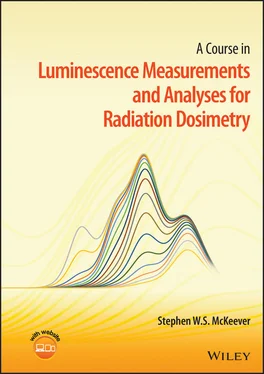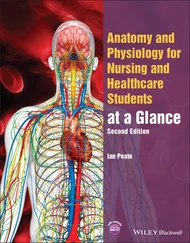A Course in Luminescence Measurements and Analyses for Radiation Dosimetry
by
Stephen W.S. McKeever Stillwater, US

This edition first published 2022
© 2022 John Wiley & Sons Ltd
All rights reserved. No part of this publication may be reproduced, stored in a retrieval system, or transmitted, in any form or by any means, electronic, mechanical, photocopying, recording or otherwise, except as permitted by law. Advice on how to obtain permission to reuse material from this title is available at http://www.wiley.com/go/permissions.
The right of Stephen W.S. McKeever to be identified as the author of this work has been asserted in accordance with law.
Registered Offices
John Wiley & Sons Ltd, The Atrium, Southern Gate, Chichester, West Sussex, PO19 8SQ, UK
John Wiley & Sons, Inc., 111 River Street, Hoboken, NJ 07030, USA
Editorial Office
John Wiley & Sons Ltd, The Atrium, Southern Gate, Chichester, West Sussex, PO19 8SQ, UK
For details of our global editorial offices, customer services, and more information about Wiley products visit us at www.wiley.com.
Wiley also publishes its books in a variety of electronic formats and by print-on-demand. Some content that appears in standard print versions of this book may not be available in other formats.
Limit of Liability/Disclaimer of Warranty
In view of ongoing research, equipment modifications, changes in governmental regulations, and the constant flow of information relating to the use of experimental reagents, equipment, and devices, the reader is urged to review and evaluate the information provided in the package insert or instructions for each chemical, piece of equipment, reagent, or device for, among other things, any changes in the instructions or indication of usage and for added warnings and precautions. While the publisher and authors have used their best efforts in preparing this work, they make no representations or warranties with respect to the accuracy or completeness of the contents of this work and specifically disclaim all warranties, including without limitation any implied warranties of merchantability or fitness for a particular purpose. No warranty may be created or extended by sales representatives, written sales materials or promotional statements for this work. The fact that an organization, website, or product is referred to in this work as a citation and/or potential source of further information does not mean that the publisher and authors endorse the information or services the organization, website, or product may provide or recommendations it may make. This work is sold with the understanding that the publisher is not engaged in rendering professional services. The advice and strategies contained herein may not be suitable for your situation. You should consult with a specialist where appropriate. Further, readers should be aware that websites listed in this work may have changed or disappeared between when this work was written and when it is read. Neither the publisher nor authors shall be liable for any loss of profit or any other commercial damages, including but not limited to special, incidental, consequential, or other damages.
Library of Congress Cataloging-in-Publication Data
Names: McKeever, S. W. S., 1950 - author.
Title: A course in luminescence measurements and analyses for radiation dosimetry / by Stephen W. McKeever.
Description: Chichester, John Wiley & Sons, 2022. | Includes bibliographical references and index.
Identifiers: LCCN 2022000515 (print) | LCCN 2022000516 (ebook) | ISBN 9781119646891 (hardback) | ISBN 9781119646914 (pdf) | ISBN 9781119646921 (epub)
Subjects: LCSH: Luminescence. | Radiation dosimetry. | Radiation-Measurement.
Classification: LCC QC476.5. M35 2022 (print) | LCC QC476.5(ebook) | DDC 535/.35--dc2 3/eng20220218
LC record available at https://lccn.loc.gov/2022000515LC ebook record available at https://lccn.loc.gov/2022000516
Cover image: Courtesy of Stephen W.S.McKeever
Cover design by Wiley
Set in 10/12pt and TimesLTStd by Integra software private Ltd, Puducherry, India.
To Claire, Declan, James and Lydia
1 Cover
2 Title page A Course in Luminescence Measurements and Analyses for Radiation Dosimetry by Stephen W.S. McKeever Stillwater, US
3 Copyright
4 Dedication
5 Preface
6 Acknowledgments
7 Disclaimer
8 About the Companion Website
9 Part I Theory, Models, and Simulations 1 Introduction 1.1 How Did We Get Here?1.2 Introductory Concepts for TL, OSL, and RPL1.2.1 Equilibrium and Metastable States1.2.2 Fermi-Dirac Statistics1.2.3 Related Processes1.3 Brief Overview of Modern Applications in Radiation Dosimetry1.3.1 Personal Dosimetry1.3.2 Medical Dosimetry1.3.3 Space Dosimetry1.3.4 Retrospective Dosimetry1.3.5 Environmental Dosimetry1.4 Bibliography of Luminescence Dosimetry Applications 2 Defects and Their Relation to Luminescence 2.1 Defects in Solids2.1.1 Point Defects2.1.2 Extended Defects2.1.3 Non-Crystalline Materials2.2 Trapping, Detrapping, and Recombination Processes2.2.1 Excitation Probabilities2.2.1.1 Thermal Excitation2.2.1.2 Optical Excitation2.2.2 Trapping and Recombination Processes 3 TL and OSL: Models and Kinetics 3.1 Rate Equations: OTOR Model3.2 Analytical Solutions: TL Equations3.2.1 First-Order Kinetics3.2.2 Second-Order and General-Order Kinetics3.2.3 Mixed-Order Kinetics3.3 Analytical Solutions: OSL Equations3.3.1 First-Order Kinetics3.3.1.1 Expressions for CW-OSL3.3.1.2 Expressions for LM-OSL3.3.1.3 Expressions for POSL3.3.1.4 Expressions for VE-OSL3.3.2 Non-First-Order Kinetics3.4 More Complex Models: Interactive Kinetics3.4.1 Thermoluminescence3.4.2 Optically Stimulated Luminescence3.5 Trap Distributions3.6 Quasi-Equilibrium (QE)3.6.1 Numerical Solutions: No QE Assumption3.6.2 P and Q Analysis3.6.3 Analytical Solutions: No QE Assumption3.7 Thermal and Optical Effects3.7.1 Thermal Quenching3.7.1.1 Mott-Seitz Model3.7.1.2 Schön-Klasens Model3.7.1.3 Tests for Thermal Quenching3.7.2 Thermal Effects on OSL3.7.2.1 Effects of Shallow Traps3.7.2.2 Effects of Deep Traps: Thermally Transferred OSL (TT-OSL)3.7.3 More Temperature Effects for TL and OSL3.7.3.1 Phonon-coupling3.7.3.2 Shallow Traps3.7.3.3 Sub-Conduction Band Excitation3.7.3.4 Random Local Potential Fluctuations (RLPF)3.7.4 Optical Effects on TL3.7.4.1 Bleaching3.7.4.2 Phototransferred TL (PTTL)3.8 Tunneling, Localized and Semi-Localized Transitions3.8.1 Tunneling3.8.1.1 General Considerations3.8.1.2 Ground-State Tunneling3.8.1.3 Excited-State Tunneling3.8.1.4 Decay during Irradiation3.8.1.5 Effect of Tunneling on TL and OSL3.8.2 Localized and Semi-localized Transition Models3.8.2.1 Localized Transition Model3.8.2.2 Semi-Localized Transition Model3.8.2.3 Semi-Localized Transitions and the TL Glow Curve3.9 Master Equations 4 RPL: Models and Kinetics 4.1 Radiophotoluminescence and Its Differences with TL and OSL4.2 Background Considerations4.3 Buildup Kinetics4.3.1 Electronic Processes4.3.2 Ionic Processes4.3.3 More on Buildup Processes4.3.3.1 After Irradiation4.3.3.2 During Irradiation4.3.3.3 Temperature Dependence 5 Analysis of TL and OSL Curves 5.1 Analysis of TL Glow Curves5.2 Analytical Methods for TL5.2.1 Partial-Peak Methods5.2.1.1 A Single TL Peak with a Discrete Value for Et5.2.1.2 Multiple Overlapping Peaks, and Trap Energy Distributions5.2.2 Whole-Peak Methods5.2.3 Peak-Shape Methods5.2.4 Peak-Position Methods5.2.5 Peak-Fitting Methods5.2.5.1 Principles5.2.5.2 Peak Resolution5.2.5.3 CGCD Using More-Than-One Heating Rate5.2.5.4 Continuous Trap Distributions5.2.6 Calculation of s5.2.7 Potential Distortions to TL Glow Curves5.2.7.1 Thermal Contact5.2.7.2 Thermal Quenching5.2.7.3 Emission Spectra5.2.7.4 Self-Absorption5.2.8 Summary of Steps to Take using TL Curve Fitting5.2.9 Isothermal Analysis5.3 Analytical Methods for OSL5.3.1 Curve-Shape Methods5.3.1.1 CW-OSL5.3.1.2 LM-OSL5.3.2 Variable Stimulation Rate Methods: LM-OSL5.3.3 Curve-Fitting Methods5.3.3.1 The Curve Overlap Problem5.3.3.2 Simultaneous Fitting of LM-OSL Peaks Generated by Varying the Stimulation Rate5.3.4 How Can the Number of Traps Contributing to OSL Be Determined?5.3.4.1 tmax-tstop Analysis5.3.4.2 Comparison with TL5.3.5 Variation with Stimulation Wavelength5.3.6 Trap Distributions5.3.7 Emission Wavelength5.3.8 Summary of Steps to Take using OSL Curve Fitting5.3.9 OSL due to Optically Assisted Tunneling5.3.10 VE-OSL
Читать дальше













